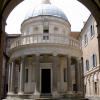The Five Orders of Architecture: Sebastiano Serlio (1537/1611)
Commentary
The key work of classical architecture was Vitruvius’ De architectura, which systematized architecture based on the Five Orders, and led to a more scholarly interest in the architectural remains of the Greeks and Romans. There was a re-emphasis on Vitruvius during the Renaissance, and led to the publication of numbers of works which built upon and interpreted his theories – above all, the writings of Mannerist architect Sebastiano Serlio (1475-c.1554).
The works of Serlio, variously known as I sette libri dell'architettura ("Seven Books of Architecture") or Tutte l'opere d'architettura et prospetiva ("All the works on architecture and perspective"), were the first comprehensive treatise on architecture since Vitruvius and played a formative role in the reception of classical architecture north of the Alps. Most decisive of all was Serlio's role canonizing the doctrine of the five orders of classical architecture: the Italian original of the engraving reproduced here is the first image in which all five are depicted together.
The seven treatises which make up the work were originally published separately, starting (strangely) with book IV, treating the orders themselves, which appeared under the title Regole generali di architetura from the Venetian presses of Francesco Marcolini in 1537. Frequently reprinted separately and together, and translated into Dutch, French, German, Spanish and finally English, their bibliography is extremely complicated: an excellent guide can be found here. Serlio's letter to the reader (Image 3) outlines the contents of the series. A modern summary is available here.
As the title of this first English translation indicates, this work, like many other architectural trends, reached England via Flemish and Dutch intermediaries. The STC's note recounts this transmission in more detail: 'The woodcuts for the title-page borders and illustrations were first used in the Antwerp edition of 1553. They were later used in the 1606 edition in Dutch printed in Amsterdam by C. Claeszoon, who also printed them on sheets otherwise blank and shipped them to Basel, where letterpress in German was overprinted in 1608, and to London for the present edition. Thomas Snodham printed only the bifolium following the first title page.'
For an introduction to the orders it is difficult to improve on John Summerson's classic book, The Classical Language of Architecture, ch. 1. For the sake of variety or revision, a textual description and a introductory video are available from the Kahn Academy.
Source: Glasgow School of Art Library. Licence: CC by-nc-sa/2.5/Scotland. From https://archive.org/stream/firstbookeofarch00serl#page/238/mode/2up
Serlio, Sebastiano, 1475-1554; Peake, Robert, Sir, 1592?-1667 (translator). 1611. The fourth Booke. Rules of Masonrry, or Building with Stone or Bricke. made after the five maners or orders of Building, viz. Tuscana, Dorica, Ionica, Corinthia and Composita : and thereunto are added examples of Antiquities; which, for the most part, agree with the instructions of Vitruvius.... Translated out of Italian into Dutch, and out of Dutch into English. London : Printed [by Simon Stafford and Thomas Snodham] for Robert Peake.
Bibliographical reference: STC (2nd ed.) / 22235. Physical description: [3], 13, [1]; 26, [1]; [1], 73; 71, [1]; 16 leaves. Books 2-5 each have separate title page, foliation, and register.

